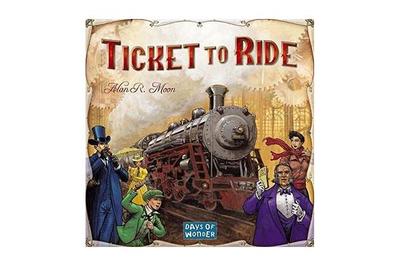Top pick
The gameplay of Ticket to Ride is quite simple. (It’s one of Wirecutter’s favorite beginner board games for adults). Players use different-colored cards to place plastic trains, completing various routes across the United States and southern Canada—the longer the route, the more points awarded.
Each player starts the game with up to three Destination Tickets, which contain paths of connected train routes, with the option to pick up more Destination Tickets throughout the game. You gain points for both individual routes (such as Houston to New Orleans) and Destination Ticket paths (such as Los Angeles to Miami). The player with the most points at the end of the game wins.
Its nuance lies in its simplicity: The rules are easy to understand, but the strategies are plentiful. There is no universally correct strategy to take—you can go on the offensive or stay defensive, be sneaky or be blatantly aggressive.

One game, you could go high-risk-high-reward by focusing on Destination Tickets—racking up more points but risking losing them if you can’t complete the full path by the end of the game. (If you are left with an unfulfilled Destination Ticket when the game ends, you subtract that ticket’s value from your final score.)
Alternatively, you might focus on securing highly sought-after routes, building your score while blocking your opponents’ paths. You can decide to fight for the longest continuous path (worth 10 bonus points) or claim all of the longest individual routes (worth 15 points each). The possibilities are endless, keeping the game unpredictable and entertaining enough to play multiple rounds in a row.
It’s because of that variety and ease that Ticket to Ride became a staple in the Rimm household.
I grew up playing board games with my family, and we’re especially partial to old-school classics like The Game Of Life, Sorry!, and Monopoly. So when I pulled out Ticket to Ride, my parents and brother, sunstruck from their too-hot adventure, eagerly reached for the bags of colorful trains.
Thanks to the game’s simplicity, we learned the rules swiftly, and the gameplay quickly went from civil to ruthless. We competed for strategic routes and the longest continuous path, giggling and cursing as we attempted to race our trains around the country. We played round after round, discovering new strategies as we went. By the time we looked up, the sun had set. A new game had sewn itself into the fabric of our family.
Playing Ticket to Ride has become something of an initiation into the family. The first time my then-girlfriend, now-wife joined in on a game, I watched with bated breath as she moved her trains from New York to Pittsburgh, and from Pittsburgh to Chicago. On the other side of the board, I saw my parents racing along the West Coast—observing my mom making the classic nine-point journey from Los Angeles to Seattle, and my dad going southbound from Calgary. With one of the two coveted Seattle-to-Portland routes already claimed, tension brewed as the turn shifted to my partner. With a glint in her eye and her trains in the East, she played a single card and placed a train in the remaining Seattle-to-Portland slot—blocking my mom and foiling her plan. My mom let out a shriek of horror and amazement; my partner had outsmarted the smartest person in the room and secured a permanent place at the table. By the following year, we were engaged.

And then the pandemic hit, and the game went from staple to savior.
The five of us (a scientist, an executive coach, a college student, a creative director, and a journalist) piled into my parents’ house outside of Boston for what we thought would be a week or two.
Weeks turned to months, days bled into nights, outside was terrifying, inside was all-encompassing. All we had was each other—and Ticket to Ride.
Because of the relatively short length of each round (30 to 60 minutes), it was the perfect transition from workday to evening. Every day around 6 p.m., the first person to finish their day would float from room to room singing The Beatles’ classic: “She’s got a ticket to ride, she’s got a ticket to ri-i-iiide.”
People would emerge from their makeshift home offices and take out their headphones, and by 6:15 we were all at the dining room table, passing out trains and setting up cards. We were five different people with 40 years between us, plucked from our daily lives. We could never agree on a movie, but we could always agree on Ticket to Ride.
In the years since, the board game has remained a mainstay in the fabric of our family. When my wife and I moved in 2021, the first package to arrive was a housewarming gift from my parents: our very own Ticket to Ride. And we’ve started giving it to friends ourselves. Available in 15-plus iterations with maps ranging from Europe to Manhattan to Japan, the game comes in a version for everyone—even those who are notoriously difficult to shop for.
We’ve added other games to our rotation—Settlers of Catan, Codenames, the Trekking series—but we love to return to our favorite trains. When it comes to Ticket to Ride, and demolishing my family’s transcontinental railroad dreams, I will always be all aboard.
This article was edited by Alexander Aciman and Catherine Kast.





